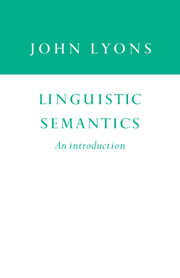1 - Metalinguistic preliminaries
Published online by Cambridge University Press: 05 June 2012
Summary
INTRODUCTION
In this chapter, which constitutes the whole of Part 1, we deal with a number of concepts which are fundamental to the whole enterprise of putting linguistic semantics on a sound theoretical footing. Although it is one of the longest chapters in the book and includes several sections containing material which, at times, is quite demanding for those who are new to the subject, I have deliberately not divided it into two (or more) chapters, because I wish to emphasize the fact that everything that is dealt with here hangs together and is equally relevant throughout.
Readers who find some of the material difficult on a first reading should not be too concerned about this. They can come back to it as they proceed through the following three parts of the book and see how the various technical distinctions that are drawn here are actually used. Indeed, this is the only way of being sure that one has understood them. The fact that I have brought together, at the beginning of the book, some of the more fundamental terminological and notational distinctions which are relevant throughout should make it easier for readers to refer back to them. It should also make it easier for them to see how the conceptual and terminological framework that I am adopting compares with that adopted in other works that are referred to in ‘Suggestions for further reading’.
- Type
- Chapter
- Information
- Linguistic SemanticsAn Introduction, pp. 1 - 45Publisher: Cambridge University PressPrint publication year: 1995

